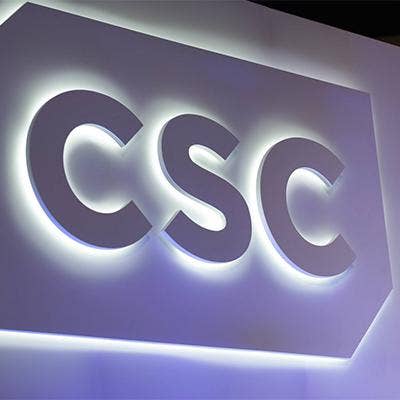10 Things You Need To Know About The CSC-HPE Deal

The Reasons: Bigger, Better, And Aimed At The Future
The planned merger of Hewlett Packard Enterprise's Enterprise Services unit into CSC will not only create a $26 billion solution provider powerhouse, but is also aimed squarely at where the business of technology services is heading, the CEOs of both firms said last week.
CSC's Mike Lawrie and HPE CEO Meg Whitman announced the deal on each company's earnings call last week, stating that the merger will create a company that will focus on next-generation solutions, such as cloud and mobility.
The resulting new entity will have an estimated 5,000 clients across 70 countries and achieve first-year cost savings of $1 billion, according to CSC.
"This merger truly moves the combined businesses into the upper echelon of global IT services players," Lawrie said.
What 10 things do you need to know about the deal? Read on.
Get all of CRN's DXC Technology coverage here.

The Merger Will Allow CSC To Capture More Business, Including From Larger Companies
CSC CEO Lawrie said the merger will allow CSC to serve large clients that are looking to move into digital environments, an area CSC hasn't been able to penetrate. He said there is a demand in the enterprise market for those shifts to digital.
The added scale that CSC will be able to leverage -- along with the financial stability Lawrie anticipates the new company to have, will allow CSC to invest in larger clients on a scale CSC has never been able to do.

Both Companies Have Seen Losses In Their Traditional Services Businesses
This merger is the "natural next step" in the restructuring plans for both HPE and CSC, according to CSC CEO Lawrie.
Those were kick-started when both companies realized losses from their traditional IT outsourcing clients that stopped doing business with them or wound down contracts.
For HPE, that winding down has been ongoing since it began reporting its financials in 2013, when it was part of Hewlett Packard. Since then, HPE's Enterprise Services group reported an annual revenue loss of between 5 percent and 11 percent, adding up to a 22 percent drop from 2013 to 2015.
Lawrie said CSC has faced similar issues. But he noted that both companies have begun seeing turnarounds, thanks to cost reductions and investments in next-generation technologies.

Who Will Run The New Company?
After the merger, CSC's Lawrie (pictured) will remain president and CEO, while HPE President and CEO Whitman will join the company's new board. The remaining board positions will be appointed equally by HPE and CSC. CSC's CFO, Paul Saleh, will continue in his role, while Mike Nefkens, the current executive vice president and general manager of HPE Enterprise Services, will be a key part of the leadership team.
Lawrie said other executives and directors will be announced at a later date.

The Merger May Leave CSC Competing With Its Spinoff, CSRA
When it broke off its public sector business, CSC included a non-compete agreement with what is now CSRA, pledging not to take on any new business that competes with it. That included any potential acquisitions or mergers CSC might execute until November 2017. According to one analyst, about 10 percent of the new company will be in the federal business in direct competition with CSRA.
When CSRA CEO Larry Prior (pictured) was asked about the potential competition between the two companies, he said CSRA is "tremendously interested" in strategic opportunities that could arise from the merger.

This Could Signal The Start Of A Big Change In The Market
During HPE's earnings call Tuesday, CEO Whitman said she believes the IT outsourcing industry will consolidate and the timing of this acquisition is right.
Whitman said the two companies decided to make the move now in order to head off that trend, noting that HPE's Enterprise Solutions group will grow faster following the merger -- which is expected to close in March 2017 -- and stockholders will be best-served with a deal that's struck early in the trend rather than later, noting that investors will get the "best of both worlds," benefiting from an early consolidation.
"It's better to be on the front end of the consolidation play than the bank end of the consolidation play," she said.

Each Company Appears To Have Benefited From Last Year's Spinoffs
Last year, CSC spun off its public sector business, now known as CSRA, while HPE was created by the spinoff of Hewlett Packard. A big reason for those splits? To enable better agility in a changing marketplace and to drive a clearer focus on their individual missions. This merger is a clear example of that added agility.
"The combination of CSC with HPE's Enterprise Services is a significant and logical next step forward for both companies in their transformation journey," Lawrie said. "It will create, a world-class agile and versatile global technology services firm, best equipped to lead the digital transformations for our clients," Lawrie said.

CSC Is Getting Used To This Acquisition Thing
After its separation from its public sector security business, CSC launched into acquisition mode, grabbing up three companies within the past six months and boosting its next-generation capabilities.
In November, the company bought Australia's largest independent and publicly owned IT services company, UXC Ltd., for $307.9 million; in December, it bought London-based outsourcing business Xchanging for $720 million; and -- just last week, on Monday -- it picked up European IT service provider Nyon, Switzerland-based Aspediens.
Lawrie said the acquisitions were important for CSC, but were a slower way of bringing it the "critical mass" that it will have following the merger with the HPE unit.
With these acquisitions, CSC has acquired more ability in next-generation, cloud-based solutions, which will help its integration with HPE Enterprise Services, combining the two businesses' capabilities in next-generation technology solutions.

The re Is Little Overlap In The Companies' Customer Bases
One of the largest benefits of the merger, according to Lawrie, is that the two companies complement each other well, with little overlap in the vertical industries they serve.
HPE's Enterprise Services division's strongest plays are in pharmaceuticals, transportation, travel and telecom, according to Lawrie, while CSC's lie in insurance, health care and financial services.
Lawrie said that out of each side's top 200 accounts, there's less than a 15 percent overlap in the revenue streams.

There Are A Lot Of Costs That Can Be Squeezed Out
Lawrie said the "big thing" about the merger, when it comes to creating short-term value, lies in synergies. The deal is expecting to squeeze out $1 billion in costs in the first year and $1.5 billion per year thereafter, for a savings of nearly 6 percent a year of the new company's potential annual revenue.
Lawrie said the savings will be seen in the consolidation of 95 data centers the two companies operate and in the moves the companies are making to adjust their workforces so that 50 percent of the employees will wind up working in the most suitable, "low-cost" countries to maximize savings and efficiency, or what he called "right-shoring." Altogether, the companies have about 165,000 employees, but are in the middle of paring their payrolls as part of restructuring plans.

The New Company Will Come Out Of The Gate With $3B-Plus In Next-Generation Technology Business, Starting Its Shift Away From Legacy IT Outsourcing
Lawrie said one of the largest benefits of the merger for CSC is HPE Enterprise Services' next-generation capabilities. After the merger, he expects that the new entity will have over $3 billion in business from next-generation technology offerings, such as those around cloud and mobility.
"That is growing on both our side and on the HPE Enterprise Services side," he said, adding that growth will eclipse the losses both companies have been seeing in legacy IT outsourcing contracts.
As for the rest of the company's revenue base, about $8 billion will come from global business services focusing on applications and mobility, with the rest -- $15 billion -- coming from traditional IT outsourcing.
"Our profile around next-generation offerings gets strengthened pretty dramatically with this merger," he said.